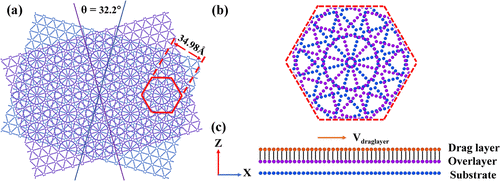Abstract
Structural superlubricity is a fascinating physical phenomenon that plays a significant role in many scientific and technological fields. Here, we report the robust superlubricating state achieved on the interface of relatively rotated graphdiyne (GDY) bilayers; such an interface with ultralow friction is formed at nearly arbitrary rotation angles and sustained at temperatures up to 300 K. We also identified the reverse correlation between the friction coefficient and size of the Moire ' lattice formed on the surface of the incommensurate stacked GDY bilayers, particularly in a small size range. Our investigations show that the ultralow friction and the reduction of the friction coefficient with the increase in size of the Moire ' lattice are closely related to the interfacial energetics and charge density as well as the atomic arrangement. Our findings enable the development of a new solid lubricant with novel superlubricating properties, which facilitate precise modulation of the friction at the interface between two incommensurate contacting crystalline surfaces.

Keywords Plus:MOLECULAR-DYNAMICSGRAPHYNEGRAPHENEENERGYWEAR
Published in ACS APPLIED MATERIALS & INTERFACES,Volume13;10.1021/acsami.1c09970,SEP 1 2021


